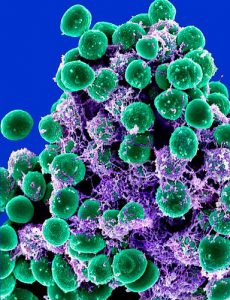
For thousands of years, the leaves of the Camellia Sinensis plant have been used as medicine.
Among the many benefits of green tea, there is an antibacterial effect, which we’ll take a look at in this post.
Basically, this is a summary of research papers that I’ve found regarding the antibacterial property of green tea.
Active components in green tea
Most of the research focuses on catechins, mainly EGCG, and to a lower extent ECG. In fact, many of the health benefits of green tea that have been studied are due to it’s EGCG content.
Caffeine has also shown an inhibitory effect against bacteria, specifically for Bacillus subtilis, and Staphylococcus aureus according to a 2011 study. However, it does so only in high concentrations.
Green tea as an antibacterial agent
Numerous studies have shown that green tea can inhibit or even kill a variety of bacteria at a concentration typical of a brewed cup of tea.
The mechanism in which compounds found in green tea attack bacteria are based on their interaction with the cell membrane. It reduces membrane fluidity by acting on the hydrophilic and hydrophobic regions of membrane bilayers.
Furthermore, even at sub-inhibitory levels, EGCG and ECG are able to decrease bacterial virulence factors.
For example, studies have shown that EGCG can prevent the adhesion of bacteria to human cells, which is the first step in avoiding an infection.
Research so far shows that green tea has an antiobiotic effect against: Staphylococcus aureus, S. epidermidis, Vibrio cholerae O1, V. cholerae non O1, V. parahaemolyticus, V. mimicus, Campylobacter jejuni, and Plesiomonas shigelloides.
There’s an important find regarding methicillin-resistant Staphylococcus aureus (MRSA), which is a bacteria resistant to many antibiotics and causes infections that are difficult to treat. EGCG can reverse methicillin resistance in MRSA, which may be useful in future treatments against this type of bacteria.
Sources:
Antimicrobial activity of Japanese green tea; present position and future prospects
Effects of green tea catechins on membrane fluidity
Potential activity of the purine compounds caffeine and aminophylline on bacteria





January 3, 2014
Thank you for sharing. Very interesting information. Have there been any follow up studies on methicillin resistance?
January 3, 2014
Hello Breda
I haven’t found anything new. The last study about it is from August 2013.
January 6, 2014
This is really great information. Awesome job finding and compiling it, Ricardo! 😀
January 6, 2014
Thank you Griff.
It took me a while to research, but sharing the info with everyone is worth it.